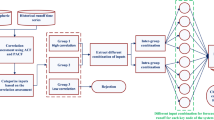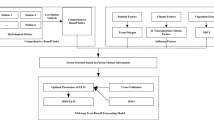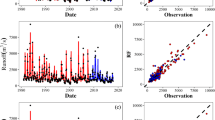Abstract
Medium- to long-term runoff forecasting on monthly timescales is an important aspect of formulating long-term water resource dispatch plans, making it of great significance to water resource management. Current research on such forecasting mostly focuses on attempts to determine the correlation between various factors and the runoff process using mathematical methods. Linear or nonlinear methods are used to establish direct or indirect conversion equations that express the relationship between high-correlation factors and runoff. However, the hydrologic cycle is a large and complex system that has chaotic characteristics. Because the system cannot be accurately depicted using existing mathematical methods, models based on these methods have limited forecasting abilities. This study developed and tested an Ensemble–KNN forecasting method based on historical samples, thereby partially avoiding uncertainties caused by modeling inaccuracies. Precipitation disturbances were used to generate the precipitation dataset that enabled the model to produce ensemble forecasts. This approach somewhat reduced the impact of uncertainties inherent in precipitation forecasts. The Ensemble–KNN forecasting method was then used to generate medium- to long-term inflow forecasts for the Danjiangkou Reservoir in China, which is the water source for the South-to-North Water Diversion Middle Route Project. The results proved the validity and reliability of the proposed modeling method.





Similar content being viewed by others
References
Ahmadi A, Karamouz M, Moridi A (2010) Robust methods for identifying optimal reservoir operation strategies using deterministic and stochastic formulations. Water Resour Manag 24(11):2527–2552
Akbari M, Overloop PJ, Afshar A (2011) Clustered K nearest neighbor algorithm for daily inflow forecasting. Water Resour Manag 25(5):1341–1357
Banihabib ME, Bandari R, Peralta RC (2019) Auto-regressive neural-network models for long Lead-time forecasting of daily flow. Water Resour Manag 33:159–172
Chen L, Ye L, Singh V, Zhou J, Guo S (2014) Determination of input for artificial neural networks for flood forecasting using the copula entropy method. J Hydrol Eng 33(6):25–29
Cover TM, Hart PE (1967) Nearest neighbor pattern classification. IEEE T Inform Theory 13(1):21–27
Fang W, Huang SZ, Ren K, Huang Q, Huang GH, Cheng GH, Li KL (2019) Examining the applicability of different sampling techniques in the development of decomposition-based streamflow forecasting models. J Hydrol 568:534–550
Ghumman AR, Al-Salamah IS, AlSaleem SS, Haider H (2017) Evaluating the impact of lower resolutions of digital elevation model on rainfall-runoff modeling for ungauged catchments. Environ Monit Assess 189(2):54
Hadi SJ, Tombul M (2018) Streamflow forecasting using four wavelet transformation combinations approaches with data-driven models: a comparative study. Water Resour Manag 32(14):4661–4679
Jamileh F, Ahmad FF, Saeed L (2014) Modeling of monthly rainfall and runoff of Urmia lake basin using “feed-forward neural network” and “time series analysis model”. Water Resour & Ind 7-8:38–48
Kobold M, Suselj K (2005) Precipitation forecasts and their uncertainty as input into hydrological models. Hydrol Earth Syst Sci 9(4):322–332
Komasi M, Sharghi S (2016) Hybrid wavelet-support vector machine approach for modelling rainfall–runoff process. Water Sci Technol 73(8):1937–1953
Li SY, Cheng XL, Xu ZF, Han HY, Zhang QF (2009) Spatial and temporal patterns of the water quality in the Danjiangkou reservoir, China. Hydrolog SCI J 54(1):124–134
Li SY, Li J, Zhang QF (2011) Water quality assessment in the rivers along the water conveyance system of the middle route of the south to north water transfer project (China) using multivariate statistical techniques and receptor modeling. J Hazard Mater 195:306–317
Li Y, Xiong W, Zhang WL, Wang C, Wang PF (2016) Life cycle assessment of water supply alternatives in water-receiving areas of the south-to-north water diversion project in China. Water Res 89:9–19
Liang ZM, Tang TT, Li BQ, Liu T, Wang J, Hu YM (2017) Long-term streamflow forecasting using SWAT through the integration of the random forests precipitation generator: case study of Danjiangkou reservoir. Hydrol Res 49(5):1513–1527
Liang ZM, Li YJ, Hu LY (2018) A data-driven SVR model for long-term runoff prediction and uncertainty analysis based on the Bayesian framework. Theor Appl Climatol 133:137–149
Mehr AD, Kahya E, Yerdelen C (2014) Linear genetic programming application for successive-station monthly streamflow prediction. Comput Geosci 70:63–72
Modaresi F, Araghinejad S (2014) A comparative assessment of support vector machines probabilistic neural networks, and K-nearest neighbor algorithms for water quality classification. Water Resour Manag 28:4095–4111
Moeeni H, Bonakdari H, Ebtehaj I (2017) Integrated SARIMAwith neuro-fuzzy systems and neural networks for monthly inflow prediction. Water Resour Manag 31(7):2141–2156
Nourani V, Alizadeh F, Roushangar K (2016) Evaluation of a two-stage SVM and spatial statistics methods for modeling monthly river suspended sediment load. Water Resour Manag 30(1):393–407
Rauf A, Ghumman AR (2018) Impact assessment of rainfall-runoff simulations on the flow duration curve of the upper Indus River—a comparison of data-driven and hydrologic models. Water 10:876
Sharma SK, Tiwari KN (2009) Bootstrap based artificial neural network (BANN) analysis for hierarchical prediction of monthly runoff in upper Damodar Valley catchment. J Hydrol 374:209–222
Su J, Wang X, Liang Y, Chen B (2014) GA-based support vector machine model for the prediction of monthly reservoir storage. J Hydrol Eng 19(7):1430–1437
Valipour M, Banihabib ME, Behbahani SMR (2013) Comparison of the ARMA, ARIMA, and the autoregressive artificial neural network models in forecasting the monthly inflow of Dez dam reservoir. J Hydrol 476:433–441
Wu CL, Chau KW (2010) Data-driven models for monthly streamflow time series prediction. Eng Appl Artif Intell 23(8):1350–1367
Xie S, Huang YF, Li TJ, Liu ZY, Wang JH (2018) Mid-long term runoff prediction based on a lass and SVR hybrid method. J Bas SCI & Eng 26(4):709–722
Zhao ZY, Zuo J, George Z (2017) Transformation of water resource management: a case study of the south-to-north water diversion project. J Clean Prod 163:136–145
Acknowledgments
The authors are thankful to the anonymous reviewers for their helpful comments and suggestions. This paper was supported by the Young Elite Scientists Sponsorship Program of the China Association for Science and Technology (Grant number 2017QNRC001), the National Natural Science Foundation of China (Grant No. 51709271), and the Open Research Fund of the State Key Laboratory of Simulation and Regulation of Water Cycle in River Basin (China Institute of Water Resources and Hydropower Research, Grant No. IWHR-SKL-KF201803).
Author information
Authors and Affiliations
Corresponding author
Ethics declarations
Conflict of Interest
None.
Additional information
Publisher’s Note
Springer Nature remains neutral with regard to jurisdictional claims in published maps and institutional affiliations.
Rights and permissions
About this article
Cite this article
Yang, M., Wang, H., Jiang, Y. et al. GECA Proposed Ensemble–KNN Method for Improved Monthly Runoff Forecasting. Water Resour Manage 34, 849–863 (2020). https://doi.org/10.1007/s11269-019-02479-2
Received:
Accepted:
Published:
Issue Date:
DOI: https://doi.org/10.1007/s11269-019-02479-2




